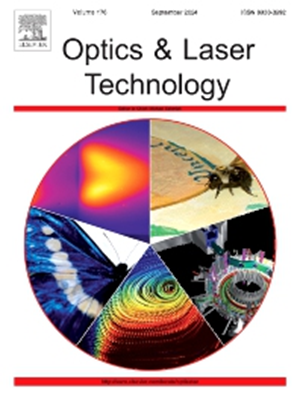Study on laser ablation of TC4 for drag reduction groove considering plasma shielding effect
IF 4.6
2区 物理与天体物理
Q1 OPTICS
引用次数: 0
Abstract
Inspired by the structure of shark skin, rib grooves have demonstrated significant potential for drag reduction in applications such as aviation and pipeline transportation. Laser ablation, owing to its high efficiency and cost-effectiveness, when combined with numerical simulations, enables precise control over the groove structure to optimize drag reduction performance. This research develops a predictive model for laser ablation that incorporates the plasma shielding effect, systematically investigating the evolution of surface morphology during the laser ablation of TC4 titanium alloy. The influence of varying laser parameters on groove morphology is analyzed, with the model’s accuracy rigorously validated against experimental data. Building on this foundation, the study further employs the simulation model to establish a quantitative relationship between groove morphology and drag reduction performance. By adjusting laser parameters, the model facilitates rapid and accurate simulation and prediction of optimal groove dimensions for maximum drag reduction, thereby guiding the fabrication of drag-reducing specimens. Experimental results reveal that, in closed-channel tests, the optimal drag reduction is achieved when the groove depth-to-spacing ratio is 0.5, yielding a maximum drag reduction rate of 11.3%. The numerical simulations presented in this study serve as a valuable tool for optimizing laser parameters and predicting the drag reduction capabilities of functional surfaces.

考虑等离子体屏蔽效应的TC4减阻槽激光烧蚀研究
受鲨鱼皮结构的启发,肋槽在航空和管道运输等应用中显示出巨大的减阻潜力。激光烧蚀,由于其高效率和成本效益,当与数值模拟相结合时,可以精确控制槽结构,以优化减阻性能。本研究建立了考虑等离子体屏蔽效应的激光烧蚀预测模型,系统研究了TC4钛合金激光烧蚀过程中表面形貌的演变。分析了不同激光参数对沟槽形貌的影响,并通过实验数据对模型的精度进行了严格验证。在此基础上,进一步利用仿真模型建立沟槽形态与减阻性能之间的定量关系。通过调整激光参数,该模型能够快速准确地模拟和预测最大减阻槽的最佳尺寸,从而指导减阻试件的制作。实验结果表明,在封闭通道试验中,槽深间距比为0.5时减阻效果最佳,最大减阻率为11.3%。本研究的数值模拟为优化激光参数和预测功能表面的减阻能力提供了有价值的工具。
本文章由计算机程序翻译,如有差异,请以英文原文为准。
求助全文
约1分钟内获得全文
求助全文
来源期刊
CiteScore
8.50
自引率
10.00%
发文量
1060
审稿时长
3.4 months
期刊介绍:
Optics & Laser Technology aims to provide a vehicle for the publication of a broad range of high quality research and review papers in those fields of scientific and engineering research appertaining to the development and application of the technology of optics and lasers. Papers describing original work in these areas are submitted to rigorous refereeing prior to acceptance for publication.
The scope of Optics & Laser Technology encompasses, but is not restricted to, the following areas:
•development in all types of lasers
•developments in optoelectronic devices and photonics
•developments in new photonics and optical concepts
•developments in conventional optics, optical instruments and components
•techniques of optical metrology, including interferometry and optical fibre sensors
•LIDAR and other non-contact optical measurement techniques, including optical methods in heat and fluid flow
•applications of lasers to materials processing, optical NDT display (including holography) and optical communication
•research and development in the field of laser safety including studies of hazards resulting from the applications of lasers (laser safety, hazards of laser fume)
•developments in optical computing and optical information processing
•developments in new optical materials
•developments in new optical characterization methods and techniques
•developments in quantum optics
•developments in light assisted micro and nanofabrication methods and techniques
•developments in nanophotonics and biophotonics
•developments in imaging processing and systems

 求助内容:
求助内容: 应助结果提醒方式:
应助结果提醒方式:


